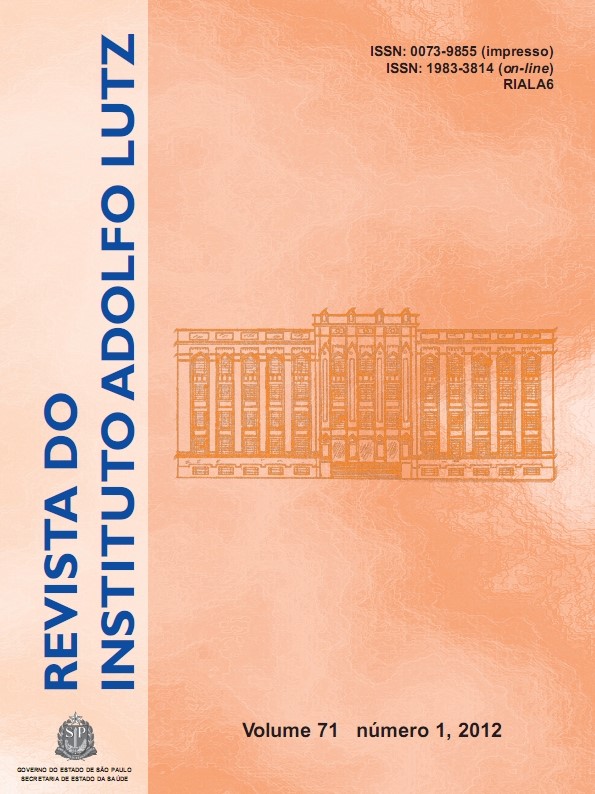Resumo
O presente estudo descreve um método voltamétrico simples e sensível para a determinação de As (III) e As (V), em μg.L-1. As (III) é determinado pela análise direta, e As (V) é convertido em As (III) por uma solução de redução. A nova concentração de As (III) representa a concentração de As inorgânico total na amostra em análise. As (V) foi determinado pela subtração do As inorgânico total e do As (III). Os limites de quantificação e detecção de As (III) foram, respectivamente, 0,22 e 0,08 μg.L-1 para o tempo de deposição de 180 s; a faixa linear foi de 1 a 5 μg.L-1 e desvio-padrão (n = 10) de 5%, em potencial de -0,68 V. A precisão foi verificada por meio de teste de recuperação em amostras fortificadas [de 98,2% para As (III) e de 96,4% para As (V)]. Estes resultados foram comparados com a análise feita por espectrometria de absorção atômica com geração de hidreto. O método voltamétrico foi aplicado na especiação do arsênio em amostras de sucos de uva contendo concentrações de 51 a 71 μg.L-1 de As (III) e 34 a 60 μg.L-1 de As (V).Referências
1. He Y, Zheng Y, Ramnaraine MM, Lock DC. Differential pulse cathodic stripping voltammetric speciation of trace level inorganic arsenic compounds in natural water samples. Analytica Chimica Acta. 2004;511:55-61.
2. Herce-Pagliai C, Moreno I, Gonzalez G, Repetto M, Camean AM. Determination of arsenic, inorganic and organic arsenic species wine. Food additives and contaminants. 2002;19:542-6.
3. Hsueh YM, Cheng GS, Wu MM, Yu HS, Kuo TL, Chen CJ. Multiple risk-factors associated with arsenic-induced skin-cancer: Effects of chronic liver-disease and malnutrition status. British Journal of Cancer. 1995;71:109-14.
4. Engel RR, Hopenhaynrich C, Receveur O. 1994. Vascular effects of chronic arsenic exposure: A review. Epidemiologic Reviews. 1994;16:184-209.
5. Carvalho LM, Nascimento PC, Bohrer D, Pilau EJ, Stefanello R. Voltammetric behavior of arsenic (III) in the presence of sodium diethyl dithiocarbamate and its determination in water and highly saline samples by adsorptive stripping voltammetric. Electroanalysis. 2006;18:1081-9.
6. Uneyama C, Toda M, Yamamoto M, Morikawa K. Arsenic in various foods: Cumulative Data. Food Additives and Contaminants. 2007;24:447-534.
7. Catarino S, Madeira M, Monteiro F, Rocha F, Curvelo-Garcia AS, Sousa B. Effect of bentonite characteristics on the elemental composition of wine. Journal of Agricultural and Food Chemistry. 2008;56:158-65.
8. Weiss KC, Bisson LF. Effect of bentonite treatment of grape juice on yeast fermentation. American Journal of Enology and Viticulture. 2002;53:28-36.
9. Cervera ML, Lopez JC, Montoro R. Determination of arsenic in orange juice by dry ashing hydride generation atomic absorption spectrometry. Microchemical Journal. 1994;49:20-6.
10. Ferreira MA, Barros AA. Determination of As (III) and Arsenic (V) in natural waters by cathodic stripping voltammetry at a hanging mercury drop electrode. Analytica Chimica Acta. 2002;459:151-9.
11. EURACHEM. The fitness for purpose of analytical methods, a laboratory guide to method validation and related topics. Teddington: LGC; 1998.
12. International Conference on Harmonization of Technical Requirements for Registration of Pharmaceuticals for Human Use (ICH). Validation of analytical procedures: methodology. Geneva: ICH/IFPMA; 1996.
13. Instituto Nacional de Metrologia, Qualidade e Teconologia (INMETRO). Orientação sobre Validação de Métodos de Ensaios Químicos: DOQ – CGCRE – 008. Rio de Janeiro; 2007.
14. Miller JC, Miller JN. Statistics for analytical chemistry. New York: Ellis Harwood; 1993.

Este trabalho está licenciado sob uma licença Creative Commons Attribution 4.0 International License.
Copyright (c) 2012 Juliana Machado de Carvalho, Katia Christina Leandro
